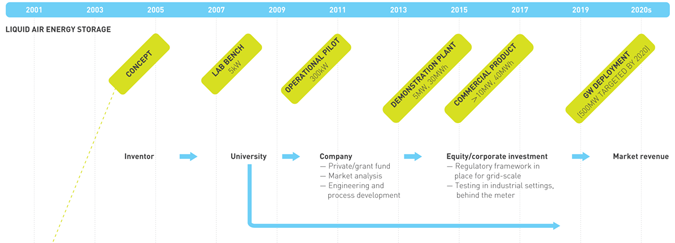Power
Under any likely scenario, balancing supply and demand on the electricity grid will become more challenging over the coming decades. About 19GW of firm generating capacity will close by the early 2020s, while large amounts of intermittent renewable and inflexible nuclear generation are expected to be added. National Grid estimates that back-up (or ‘balancing’) capacity needs to rise from 3.5GW today to some 8-13GW by 2020.
The debate around grid balancing is usually presented in terms of the need for additional gas fired plant to run when the wind drops. However, there is a powerful case for additional grid storage, in which liquid air could play a major part. Gas plant may be a reliable source of firm power, but it is a source of substantial greenhouse gas emissions, and critically, unlike storage, it cannot absorb ‘wrong time’ energy.
Much has been made of the potential impact on a wind-dependent grid of a high-pressure weather system in winter, bringing cold but windless weather with high demand and low renewable output. However, as wind capacity increases, the reverse problem will also exist: periods when wind output exceeds demand, either locally or across the entire grid, and wind generation has to be ‘constrained’ (switched off) and yet still paid for. This is already beginning to happen in Britain, where constraint payments have risen dramatically, from just £180,000 in the year to April 2011 to £34 million the following year. So far constraint payments have largely been caused by local bottlenecks in transmission lines, but if wind capacity grows as forecast, it is easy to foresee a situation in which off-peak wind generation could often exceed total demand, even if all grid bottlenecks were solved.
In this respect storage has a major advantage over gas and other forms of balancing capacity, and will become increasingly valuable to the grid by preventing the waste of ‘wrong time’ energy, and by allowing fossil power plants to run more efficiently at full load rather than ‘ramping’ up and down to compensate for variable wind output.
In this context, Liquid Air Energy Storage could:
• provide network operators and other market participants a cost effective and scalable means of time-shifting large amounts of energy to help balance the grid, deliver investment savings by allowing upgrades of transmission and distribution networks to be deferred, and eliminating grid bottlenecks;
• provide strategic levels of electricity storage: a single gasometer-style tank of the capacity currently used in the LNG industry (190,000m3) could store sufficient energy as liquid air to compensate the loss of 5GW of wind power for three hours;
• reduce CO2 emissions from grid electricity by
1) capturing excess off-peak (‘wrong time’) renewable energy and using it to displace high-emitting peaking generators, and
2) allowing fossil power plants to run more efficiently at full load rather than ramping up and down to compensate for variable wind output;
• exploit the cold given off by the re-gasification of liquefied natural gas (LNG) at UK import terminals to help produce enough liquid air to fuel 16 billion car kilometres, more than 4% of the annual mileage of cars in Great Britain; and
• compete in a potential storage market of 14GW by 2050, with a value to the grid of some £10 billion per year, assuming a level playing field regulatory framework.

